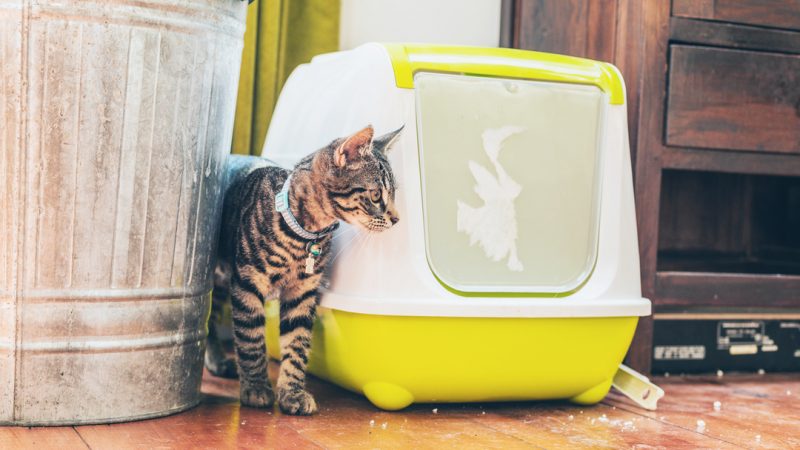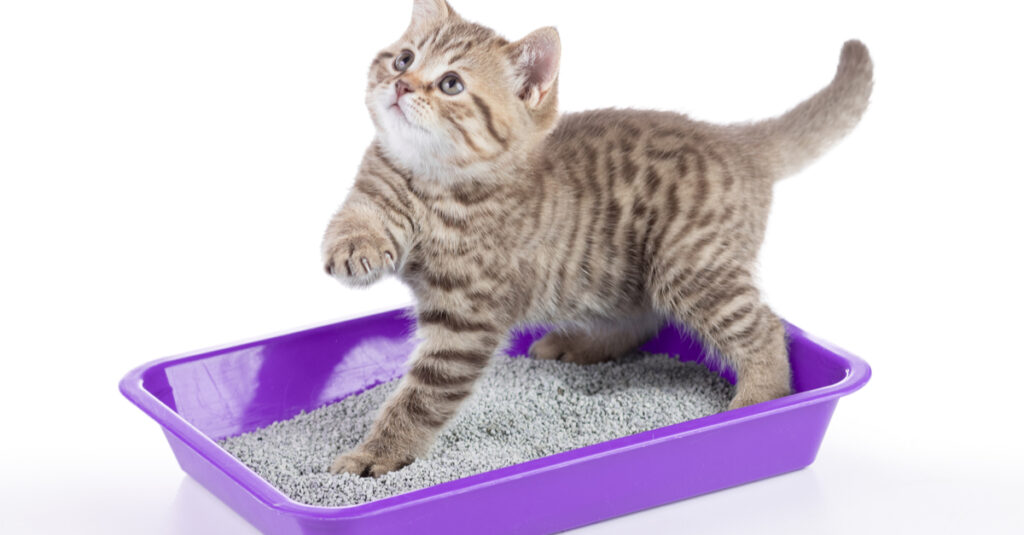New Cat Hasn’t Used Litter Box Yet: When to Be Concerned!
When bringing home, a new cat, there are many things to prepare for. Though during the first week or so, it’s very important to keep an eye on your new feline friend.
The actual training comes at a later date. A lot of cats have never been trained before and some take more time than others to learn their roles as an inside member of your family.
Grab the Puuurrr-fect Planner to keep track of your cat’s health and well-being ON SALE NOW!
Your new cat hasn’t used the litterbox yet because she is probably stressed from changing from one environment to another. She just needs some time to settle in and be more comfortable with using the bathroom. It may take anywhere from 2-3 days for new cats to get to their normal routing.

In order to resolve the problem, you’ll need to take steps to calm your new cat and help him feel at home.
Other reasons why your new cat hasn’t not used the litter box may include one or more of the following:
- The litter box is dirty. Cats do not like dirty litter boxes and will avoid them at all costs. Make sure you clean all of the litter boxes in your home on a regular basis. Tha especially if you have several cats.
- The litter box location is inconvenient for your new cat. If you have multiple cats or if there are multiple locations for your litter boxes. Make sure each one is easily accessible by all of your pets and that there is enough space for them to enter.
- Your new cat has been spooked by something in his environment (e.g., loud noises). Try turning down the volume on TVs or radios while the rest of your family is home so as not to frighten him too much when he comes.
Cat Hasn’t Used Litter Box In 12 Hours
Your cat has been using the litter box for her business, but then she suddenly stops. If this is happening to you, don’t panic.
There are many reasons why a cat may stop using her litter box. It could be anything from a simple change in routine to a medical problem.
Its normal for a cat not to use the litter box for 12 hours. Just keep an eye and take note if she won’t go to the bathroom in the next 24 hours.
Read also: Do Cats Need Access to Litter Box at Night?
Cat Hasn’t Used Litter Box In 24 Hours
It’s possible that your cat may have an infection or other medical problem that’s causing her discomfort when she urinates or defecates.
It’s also possible that something caused her pain when she urinated or defecated, which could have caused her to associate using the litter box with pain.
There are also many other reasons why your cat may not use the litter box. It is important to determine what is causing the problem and correct it quickly before it develops into a big issue. Here are some of the possible reasons why your cat may not be using the litter box:
1. Litter Box Location
If you have recently changed where you place your litter box, it is possible that your cat does not like this new location and will not use it.
If you have moved the litter box, move it back to where it was originally located and see if this helps resolve the problem.
2. Litter Box Type
Cats are very particular about certain things in their environment, including their food, water bowls, beds, etc.
So, if you have recently changed what type of litter you use or have purchased a new type of litter pan that your cat does not like, this could be causing them not to use the box anymore.
Try switching back to an old type of litter until you can find something else that both works well for them and fits into your budget.
3. Medical Problems
If your cat does not use her litter box for more than one or two days, it’s time to see your veterinarian as soon as possible
Your doctor will examine your kitty and ask you questions about her behavior, diet and medical history. He will also perform tests to rule out any medical problems that could be causing your cat’s issues with elimination.
They could be constipated and need to be treated with an enema or laxative. When this happens, they often associate the discomfort with the litter box, so they won’t go near it again.
This is also true when cats are sick or injured and don’t want to use their litter box because they associate it with pain.
4. Behavioral Issues
You may have noticed that your kitty isn’t using her litter box because she doesn’t like something about it or because there is something wrong with the location of the box itself.
Cats can get territorial over their territory. Besides they don’t like sharing with other animals or people who aren’t part of their family pack. Sometimes when we move furniture around in our homes, we accidentally disturb their environment.
New Cat Won’t Eat or Use Litter Box
It could be a number of reasons. Cats can form bonds very quickly, so it’s possible that he simply doesn’t like the new food or litter box.
If your new cat won’t eat or use the litter box, it’s possible that he has stress from the move and needs some time to adjust. You may want to consider offering him a treat after he uses the litter box or eats his meal.

Try leaving the food and the litterbox where he could easily see them even when you are away. Some cats can eat and use the litterbox only when you are away.
But you can also try feeding him in a different part of the house from where you are, so that he might feel more comfortable and less stressed by being in an area away from his old home.
New Cat Not Eating Much but Acting Normal
There are a number of reasons why a cat might not be eating much. But still appear to be acting normal. Here are some possible explanations:
The cat is still adjusting to her new home. Cats can take up to a week or longer to fully acclimate to the sights, sounds, smells and other cats in their new homes.
This can make them reluctant to eat because they’re too busy exploring their surroundings. As soon as they settle down and get used to their new surroundings, they should start eating normally again.
If your cat is acting normal but not eating much, you can help him or her adjust by making sure there’s an easily accessible litter box, food bowl and water fountain in his or her room. You can also give your cat some extra attention and playtime during this period of adjustment.
Newly Adopted Cat Not Peeing
Cats can be shy and timid when they’re first adopted. The most common reason a cat stops peeing is because they are stressed. This can happen with a new home, a new pet in the household or even if you move them to a new room in the house.
It is important to make sure that your cat has plenty of time to adjust to their new surroundings and that you give them some space to adapt to things.
However, if your cat has been home for more than two weeks and still isn’t using the litter box regularly, then there could be another medical problem at play.
If your cat is not able to urinate on their own within 48 hours of being adopted, then it may be time to take them in for medical care.
Also read: Do Cats Poop Where They Sleep?
Cat Won’t Use Litter Box Tried Everything
You’ve tried everything. You’ve cleaned the box, you’ve changed the litter, you’ve bought new toys and even a new box. You’re at your wit’s end. You aren’t sure what else to do.
It’s possible that your cat is just rejecting the litter box for some reason. Cats can be picky about their toilet habits and will sometimes reject a box for no apparent reason at all. However, there are some things that could be causing this behavior:
Cats like privacy when they go to the bathroom. This especially if they have young kittens to care for or need to protect from predators.
If the box is in an area where other animals can get into it or where it may be stepped on by people passing by all day long.
Your cat might not want to use it anymore because she doesn’t feel safe using it in front of other animals or people.
The solution here is to put the litter box somewhere else where it won’t get trampled on as much or somewhere more private, so your cat feels safer using it again.
You should try to leave the room for a few minutes and let your cat explore their new surroundings. Once they are comfortable with being there, then you can start trying to get them to use the litter box.
Because cats won’t use something that smells bad or looks dirty even if they don’t mind peeing or pooping outside of it!
How To Get New Cat to Use Litter Box?
Set up the litter box in a quiet area of the house. That way, your new cat can feel more at ease and less stressed. Make sure there’s plenty of space around the litter box so that your cat can easily get in and out of it.

Other Things You Can Do to Get New Cat to Use Litter Box
- Feed your cat near her litter box so that she becomes familiar with the area and associates it with food rewards.
- Use the same type of litter that they were used to at the shelter or rescue center. If they were using a different kind of litter there, they may not like it now that they are in your home.
- Put the litter box near where they eat and sleep so that it’s easy for them to find it when nature calls. Make sure that there are no other distractions in the room when you put down the box for them.
- Don’t put too much or too little litter in their box and make sure that there is always some clean litter available for them to use whenever they need it!
It’s best to start litter training when they’re young. But even if you don’t start until they’re adults, it can still be done successfully. If your cat has never been trained before and is older than 12 weeks old, expect that it will take some time for them to get used to using the litter box.
Conclusion
We have to understand that some time is needed for a new cat to learn to use her litter box.
As time goes on, the cat will get used to using the litter box and will likely not have a problem for the rest of its life.
On the other hand, sometimes cats just need to be adjusted to their new homes; using Feliway and adding some catnip might speed up the process. In any case, wait it out and see what happens. Hopefully this will be resolved soon.
More resources:
9 Ways to Help Your Constipated Cat | PetMD
Constipation | Cornell University College of Veterinary Medicine
